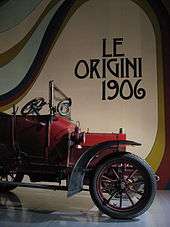Alfa Romeo 164
| Alfa Romeo 164 | |
|---|---|
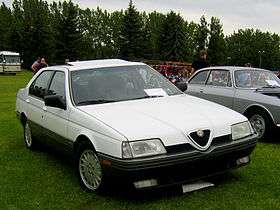 | |
| Overview | |
| Manufacturer | Alfa Romeo |
| Also called | Alfa Romeo 168 |
| Production | 1987–1998 |
| Assembly | Arese, Milan, Italy |
| Designer | Enrico Fumia (Pininfarina)[1] |
| Body and chassis | |
| Class | Mid-size luxury / Executive car (E) |
| Body style | 4-door saloon |
| Layout | Front-engine, front-wheel-drive / four-wheel-drive |
| Platform | Type Four platform[2] |
| Related |
Lancia Thema Saab 9000 |
| Powertrain | |
| Engine |
|
| Transmission |
5-speed manual 6-speed Getrag manual 4-speed ZF 4HP18Q automatic 4-speed ZF 4HP18QE automatic |
| Dimensions | |
| Wheelbase | 2,660 mm (104.7 in) |
| Length |
4,554 mm (179.3 in) (1988–90) 4,557 mm (179.4 in) (1991–92) 4,560 mm (179.5 in) (1993–94) 4,665 mm (183.7 in) (Super) |
| Width | 1,760 mm (69.3 in) |
| Height |
1,390 mm (54.7 in) (1988–90) 1,393 mm (54.8 in) (1991–92) 1,390 mm (54.7 in) (1993–95) |
| Kerb weight | 1,200–1,510 kg (2,650–3,330 lb) |
| Chronology | |
| Predecessor |
Alfa Romeo 90 Alfa Romeo Alfa 6 |
| Successor | Alfa Romeo 166 |
The Alfa Romeo 164 (codenamed Type 164) is a four-door executive saloon that was manufactured by the Italian automaker Alfa Romeo from 1987 to 1998 and designed by Pininfarina. Its predecessors of the 164 was the Alfetta, and its Alfa 6 derivative. It was superseded by the 166 in 1998, after a total of 273,857 domestic and export 164 units.[3]
Development
In October 1978, Alfa Romeo, Fiat, Lancia and Saab jointly agreed to each develop an executive saloon based on their shared Type Four platform ("Tipo 4" in Italian), to eventually compete against the likes of the Ford Granada and Opel Rekord (Vauxhall Carlton) as well as more premium saloons by BMW and Mercedes-Benz in the form of the 5-Series and E-Class, respectively.
Project 164 started life as Project 154 and was completed in 1981, then still under Alfa Romeo. A year later, that project morphed into the 164 based on the Type Four platform.[4] This new model was designed by Enrico Fumia of Pininfarina,[5] with a wedge shape that afforded it a leading drag coefficient of Cd=0.30. The design would later influence the rest of the Alfa Romeo range (starting in 1990 with the major redesign of the 33 and culminating with the 155, and also see Pininfarina adapt it for the 1987 Peugeot 405 and the 1989 Peugeot 605 sedans).
Below is a chronology of the key milestones in the development of this new vehicle:
- Initial testing of the 164's dynamic elements (engine and drivetrain) began in 1984, where mules based on the then contemporary Giulietta were used. Initial handling characteristics were honed on the factory's "Balocco" test track in Arese.
- In 1985, the first pre-production 164s were put through their paces on the road. Heavily disguised, with many false panels and even a false nose design (borrowing heavily from the then equally undeveloped 155) sporting four round headlamps, these vehicle mules served to test the 164 for the gruelling 1 million kilometre static and road testing demanded of the design.
- In 1986 and 1987, the first 150 164s were given their pre-production testing. In terms of engineering demands, these exceeded every Alfa before, and by quite a substantial margin.
- In Morocco, desert testing saw five grey 164 Twinsparks and V6s undergo the equivalent of the Paris-Dakar rally. Road conditions varied from good tarmac to off-road conditions, and accelerometers confirmed the superiority of the 164 in terms of passenger comfort. This data was cross-confirmed in the engineering laboratory with a sophisticated dummy in the driver's seat, with accelerometers both in its seat, and in its ears to mimic that of the semi-circular canals of the ear.
- The Twinspark and the V6 underwent handling trials at Arese. The Twinspark displayed very mature driving manners at the limit, with minimal skid. The V6 displayed a 25% increase in at-the-limit skid, a natural consequence of its greater nose weight.
- ABS testing confirmed that the Twinspark has superior braking to the V6. Brake linings of the 164s were run at maximum braking until they literally glowed with heat, and displayed no deviation in form. The 164 was the first Alfa to feature slotted double-walled disc brakes. At no point were the discs drilled to release excess heat, the original design being demonstrated to be excellent.
- Sound production was tested in an anechoic chamber, the car being subjected to stress and road noise testing, with instruments and with live subjects at the wheel, on a specially designed rig.
- Electromagnetic stability of the complex electronic system was also tested, in an anechoic chamber equipped with EM emitters (radar).
- The 164 engines were run to destruction, the Twinspark proving to be the most robust, and with the longest possible engine life. The V6 displayed only 10% shorter overall engine life.
Ultimately unvelied at the 1987 Frankfurt Motor Show, the 164 was the last model to be developed while the Alfa Romeo was still a fully independent company, and was formally launched a few months after the takeover by Fiat.
Design
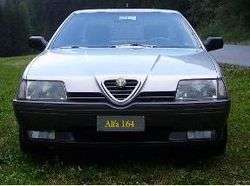
Enrico Fumia of Pininfarina was responsible for the 164 design, with the first 1:1 scale model produced in 1982.[4] Design cues were publicly revealed on the Alfa Romeo Vivace concept car, which was exhibited at the 1986 Turin Motorshow that went on to influence the design of the Alfa Romeo GTV and Spider (916 series) launched in 1993.[6][7]
The 164 became the first Alfa to benefit from extensive use of computer aided design, used to calculate structural stresses that resulted in a very rigid but still relatively lightweight chassis. Although sharing the same platform as that of the Lancia Thema, Fiat Croma and Saab 9000, by virtue of the fact that it was the last of the four to enter production, it featured unique front suspension geometry and the most distinctive styling of the lot. In fact, for example, the other cars all shared identical side door panels. Though still voluminous, the 164 had the tightest aperture to the rear boot, which had a 510-Litre capacity.
Overall, the 164 also benefitted from improved build quality relative to previous Alfas, thanks to the extensive use of galvanised steel for the frame and various body panels for the first time in the brand's history. Moreover, the car featured advanced (but notoriously troublesome[8]) electronics thanks to the most complex wiring harness fitted to any Alfa Romeo. For example: it had three onboard computers (one for air conditioning, one for instrumentation, and one for the engine management); air conditioning and instrument functions shared a multiple-mode coded Zilog Z80-class microcontroller for dashboard functioning). The instrumentation included a full range of gauges including an advanced check-panel.
Its interior was spacious and modern, available with standard velour seating or leather trim depending on the model. Its dashboard continued the avantgarde design of the exterior with a centre dashboard that was dominated by a large number of seemingly identical buttons arranged in rows. Air-direction within the ventilation system was controlled by a pair of servomechanisms, which were constructed using notoriously fragile plastic gears that were prone to failure (prompting at least one aftermarket company to develop metal replacement parts).
Again depending on the model, the 164 could feature automatic climate control and electronically controlled damping suspension - the latter, for example, in the sports-oriented Quadrifoglio Verde ("Green Cloverleaf ") and 164S models. This suspension actively reduced damping in response to conditions to provide a dynamic compromise between road holding and comfort.
Range
The 164 was only ever built as a 4-door saloon, unlike the related Type Four cars that were available in other bodystyles (i.e. Croma and 9000 hatchback; 9000 and Thema sedans; Thema wagon). In addition, until 1993, the 164 was only available as a front wheel drive like the related cars.
In its home market of Italy, the original 164 range launched in 1987 comprised the following models:[9]
- 2.0i Twin Spark (badged "T.SPARK")
- 3.0i V6 12-valve
- 2.5 Turbodiesel (badged "TD").
European export versions were fitted with catalytic converters to meet more stringent emission standards, and this included the Twin Spark Europa model.

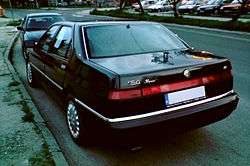
In 1990, the range was expanded by the 4-cylinder 2.0i Turbo, the sports-oriented 3.0i V6 Quadrifoglio Verde (badged "QV" or "S") and North American export versions for the 1991 model year that included the luxury-oriented 164 L ("L" for Lusso in Italian) equipped with the 3.0L V6 producing 183hp and 185 ft-lbs of torque and the 164 S (in essence, the "QV") with an uprated 200hp and 189 ft-lbs.[10][11]
Apart from minor running production upgrades, the range was revamped and became known as the 164 Super in 1993. Key differences on the outside consisted of chrome trimmings added to the upper edge of the bumpers bars and revised headlights now with a slimmer profile. Inside, there were revised instruments and a centre console that featured more delineated switchgear.
The range was now also bolstered by the following models:
- 3.0i V6 24V with a 24-valve engine upgrade
- 3.0i V6 Quadrifoglio 4 (badged "Q4"), which was the most powerful and sole all wheel drive variant built.
In the North American market, the new 24-valve version of the 3.0L V6 produced 210hp and 198lb-ft of torque in LS trim while the S model developed 230hp and 202ft-lb.[11] The 3.0L V6 was the only engine ever offered there, and 1995 would prove to be the last year an Alfa sedan would be sold there until the 2017 model year.
The 164 was rebadged as the 168 for the Hong Kong and Malaysian markets, as the number "164" had a very negative connotation (路死 — a Chinese homophone meaning "all the way to death"), and "168" has quite the opposite (路發 — meaning "all the way to prosperity").[12]
Quadrifoglio Verde

The 164 QV or Quadrifoglio Verde was available from 1990 to 1992 as the top of the range model. It was fitted with a bodykit that comprised an extended front spoiler, deeper side-skirts and a deeper rear apron. Inside, the QV featured sculpted sports seats whereas, mechanically, it was fitted with an up-rated version of the 3-Litre V6 12-valve engine (147 kW vs 132 kW for the standard car) and adjustable damper settings. This was the only export 164 available with a manual transmission (e.g. in Australia). From 1992, this model was the powered by the new 24-valve V6 engine.
Q4

In 1993, Alfa introduced a four-wheel-drive variant called the Q4 (short for Quadrifoglio 4), which was equipped with the most powerful 3-Litre V6 engine fitted to the 164, featuring 24-valves. The Q4's four-wheel-drive system ("Viscomatic") was co-developed with the Austrian company Steyr-Puch.[13] and was more advanced than others compared at the time. The system consisted of a viscous coupling unit, central epicyclic differential and Torsen differential in the rear. Connected to the ABS and "Motronic" engine management modules, the power driven to the rear axle was continuously variable from 0 to 100% subject to road conditions. Torque was distributed between axles depending on the speed, turning radius, engine rpms, throttle position and ABS parametrics. This model was equipped with a Getrag 6-speed manual gearbox.
Engines
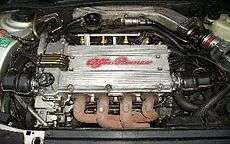
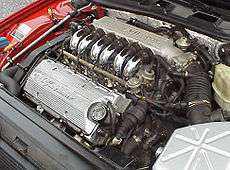
The base 164 engine was the 2.0 L Twin Spark I4 engine with two spark plugs per cylinder. Apart from that, this engine was also notable for having a two-stage valve timing system (before Honda's famous VTEC), and an induction valve blade-type system, aimed at improving low-end torque.
The block of the Twin Spark was the same 2.0 L that had been a part of Alfa's road and race car history since the 1930s. The engine featured fuel injection, controlled by a Bosch Motronic system as well as achain-driven DOHC cylinder head, a single cooling fan and generator belt, improved reliability and reduced parasitic friction. The battery of all 164s was placed in the trunk to achieve a close 50:50 weight distribution.
Next was a turbocharged 2.0 L 8-valve engine, derived from the Lancia Thema i.e. Turbo, and including an overboost feature. This was later replaced by a turbocharged 2.0 L V6, which was based on the 3.0 L engine and was fitted with a very sophisticated engine management system from Bosch.
The top-line engine was the 3.0 L "Arese" V6 designed by Giuseppe Busso originally for the Alfa 6. Its 12-valve design was later upgraded to 24-valves for the new V6 models and, specifically, the QV and Q4.
Last but not least, for Europe, there was also a turbodiesel version with an engine sourced from the Italian engine maker VM Motori. Rated at 125 PS (92 kW), even this weakest version was capable to propel the 164 past the 200 km/h (124 mph) mark.[14]
Performance
| Model | Type | Displacement | Power | Torque | 0–100 km/h | Top speed | Model year |
|---|---|---|---|---|---|---|---|
| Petrol engines | |||||||
| 2.0 T.Spark 8v | I4 | 1,962 cc (119.7 cu in) | 108 kW (148 PS) | 187 Nm (138 lb·ft) at 4700 rpm | 9.2 s | 215 km/h (134 mph) | 1987–1989 |
| 2.0 T.Spark 8v (cat) | I4 | 1,962 cc (119.7 cu in) | 106 kW (144 PS) | 187 Nm (138 lb·ft) at 4700 rpm | 9.9 s | 210 km/h (130 mph) | 1990–1992 |
| 2.0 TS 8v | I4 | 1,962 cc (119.7 cu in) | 105 kW (144 PS) | 193 Nm (142 lb·ft) at 5000 rpm | 9.9 s | 215 km/h (134 mph) | 1992–1994 |
| 2.0 TS Super 8v | I4 | 1,995 cc (121.7 cu in) | 105 kW (144 PS) | 187 Nm (138 lb·ft) at 5000 rpm | 9.9 s | 215 km/h (134 mph) | 1995–1997 |
| 2.0 Turbo 8v | I4 | 1,995 cc (121.7 cu in) | 129 kW (175 PS +overboost) | 265 Nm (195 lb·ft) at 2500 rpm | 7.2 s | 225 km/h (140 mph) | 1987–1991 |
| 2.0 V6 Turbo | V6 | 1,996 cc (121.8 cu in) | 156 kW (210 PS +overboost) | 306 N·m (226 lb·ft) at 2750 rpm | 7.2 s | 243 km/h (151 mph) | 1991–1992 |
| 2.0 V6 Turbo Super | V6 | 1,996 cc (121.8 cu in) | 151 kW (205 PS +overboost) | 30.1 N·m (223 lb·ft) at 2750 rpm | 8.0 s | 237 km/h (147 mph) | 1993–1997 |
| 3.0 V6 12v | V6 | 2,959 cc (180.6 cu in) | 141 kW (192 PS) | 261 Nm (192 lb·ft) at 4900 rpm | 8.1 s | 230 km/h (140 mph) | 1987–1989 |
| 3.0 V6 12v (cat) | V6 | 2,959 cc (180.6 cu in) | 135 kW (184 PS) | 261 Nm (192 lb·ft) at 4900 rpm | 8.1 s | 230 km/h (140 mph) | 1990–1992 |
| 3.0 V6 12v Super | V6 | 2,959 cc (180.6 cu in) | 132 kW (180 PS) | 255 Nm (188 lb·ft) at 4400 rpm | 8.0 s | 230 km/h (140 mph) | 1992–1997 |
| 3.0 V6 12v QV | V6 | 2,959 cc (180.6 cu in) | 147 kW (200 PS) | 274 Nm (202 lb·ft) at 4400 rpm | 7.7 s | 237 km/h (147 mph) | 1990–1992 |
| 3.0 V6 24v Super | V6 | 2,959 cc (180.6 cu in) | 155 kW (211 PS) | 266 Nm (196 lb·ft) at 5000 rpm | 8.0 s | 240 km/h (150 mph) | 1992–1997 |
| 3.0 V6 24v QV | V6 | 2,959 cc (180.6 cu in) | 170 kW (232 PS) | 276 Nm (203 lb·ft) at 5000 rpm | 7.0 s | 245 km/h (152 mph) | 1992–1993 |
| 3.0 V6 Q4 | V6 | 2,959 cc (180.6 cu in) | 170 kW (232 PS) | 276 Nm (203 lb·ft) at 5000 rpm | 7.7 s | 240 km/h (150 mph) | 1993–1997 |
| Diesel engines | |||||||
| 2.5 Turbodiesel | I4 | 2,499 cc (152.5 cu in) | 86 kW (117 PS) | 260 Nm (191 lb·ft) at 2200 rpm | 11.1 s | 200 km/h (120 mph) | 1987–1992 |
| 2.5 Turbodiesel | I4 | 2,499 cc (152.5 cu in) | 92 kW (125 PS) | 288 Nm (212 lb·ft) at 2000 rpm | 10.8 s | 202 km/h (126 mph) | 1992–1997 |
Product milestones
- 1981 – Alfa Romeo initiates Project 156.
- 1982 – Alfa Romeo switches to "Type Four"-based Project 164.
- 1984 – Early testing of drivetrains begins at Arese, based on Giulietta test mules.
- 1985 – External and internal design in conjunction with Pininfarina frozen at this point.
- 1985 – Summer and winter testing of prototypes occurs in Africa and Sweden, respectively.
- 1986 – Some 150 pre-series vehicles tested covering over 1 million km in extreme climates. Crash test compliance for introduction into the North American market also takes place.
- 1987 – 164 is unveiled at Frankfurt Motor Show (Series 1).
- 1988 – 164 goes on sale in Europe.
- 1990 – Minor upgrades (Series 1.5) characterised by: suspension tweaks are applied to alleviate torque steer; styling update for the taillights; introduction of Bosch electronic switchgear internally; revised instrument switchgear in "Lusso" versions.
- 1993 – Range revamped (Series 2): minor exterior restyling including new slim headlights with elipsoidal lights and revised bumpers with chrome inserts; new dashboard centre console switchgear; 3.0 L V6 engine upgraded to 24-valves, but 12-valve version remains.
- 1994 – Four-wheel drive Q4 model is introduced with the new V6 engine; new interior design and fittings, and final-series trim options introduced. (Series 3).
- 1995 – Exports to the United States cease.
- 1997 – 164 production ends.
- 1998 – 164 sales end.
Concept cars and variants
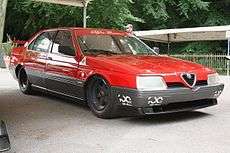
In 1991, a shortened version of the 164 platform served as the basis of the all-wheel drive Alfa Romeo Proteo coupé, which never eventuated.
The 164 also served as the basis of the Italdesign Scighera supercar concept displayed in 1997. Scighera sported the same 3-liter engine but with 2 turbochargers.
In 1988, Alfa Romeo produced the 164 Pro-Car featuring a mid-engine layout and powered by a 3.5-litre V10 engine. This unusual powerplant was originally planned to be used by the Ligier F1 team and produced 620 bhp (462 kW; 629 PS) at 13300 rpm and 39 kg·m (380 N·m; 280 lb·ft) of torque at 9500 rpm.[15] Weighing only 750 kg (1,653 lb), the 164 Pro-Car achieved a top speed of 340 km/h (211 mph) and went quarter of a mile (~400 m) in only 9.7 seconds.[15] It was planned to race in a special racing series, as a support event to Formula One Grands Prix. With Alfa Romeo being the only manufacturer to produce a car for this series, the project was ultimately cancelled. Only one rolling chassis with the Alfa Romeo V10 was built and by Motor Racing Developments Ltd.,[15] the company behind the Brabham Formula One team, which was owned by Alfa Romeo at the time.
.jpg)
The 164 was also the subjects of official and privately modified variants, the most notorious being:
- a 2-door "Vigili del Fuoco" (Italian for fire brigade[16]) pick-up version now exhibited at the Alfa Romeo Museum, produced as part of the brand's practice of supplying specially modified vehicles for use by rescue teams at racing tracks;[17]
- a station wagon version, privately modified in North America.[18]
- a limousine version, built by Top Gear in 2007. It had a Saab 9000 end, and used for a stunt segment in said show.
In Italy, in particular, armoured version were built for government officials alongside versions of the related Fiat Croma and Lancia Thema.
See also
References
- ↑ Silvia Baruffaldi (1995). "Styling cues of tradition". autodesignmagazine.com. Auto&Design. Retrieved 2012-08-28.
- ↑ "Curiosidades Tipo". Fiat Tipo Portugal. Archived from the original on 5 March 2012. Retrieved 30 December 2013.
- ↑ "164 Production". digest.net. Archived from the original on 2007-04-05. Retrieved 2007-04-25.
- 1 2 "Jaroslaw Borzdynski's interview with Enrico Fumia". bozhdynsky.com. 2012.
- ↑ "Fumia Design". fumiadesign.com. Retrieved 2012-08-12.
- ↑ "Alfa Romeo GTV and Spider Timeline". bozhdynsky.com.
- ↑ "The development of Alfa's 916 GTV & Spider". The Thinker's Garage.
- ↑ "Four of a Kind: The Alfa Romeo 164 and the "Type Four" Cars". ateupwithmotor.com. Retrieved 2010-06-12.
- ↑ Andre. "alfisti.net". alfisti.net. Retrieved 2015-08-09.
- ↑ Andre. "alfisti.net". alfisti.net. Retrieved 2015-08-09.
- 1 2 "Alfa Romeo 164 data catalogue". www.automobile-catalog.com. Retrieved 2016-09-17.
- ↑ Chris Robyn. "Alfa Romeo 168: What's in a Number?". digest.net. Retrieved 2007-04-25.
- ↑ "Alfa Romeo 164 Q4 Mechanicals". krut.se. Archived from the original on 2007-09-28. Retrieved 2007-04-25.
- ↑ "THE 164 RANGE". www.digest.net. Retrieved 2008-08-17.
- 1 2 3 "Alfa Romeo 164 Pro-Car". velocetoday.com. 2007. Retrieved 2010-07-07.
- ↑ eejyanaika1980 (2010-11-10). "Alfa Romeo 164 Vigili del Fuoco | Flickr - Photo Sharing!". Flickr. Retrieved 2015-08-09.
- ↑ "Mezzi di soccorso (e non solo....) Alfa Romeo!!!". Retrieved 2016-01-01.
- ↑ "Alfa Romeo 164 Register.com • View topic - 164 Sportswagon". Alfaromeo164register.com. Retrieved 2015-08-09.
External links
| Wikimedia Commons has media related to Alfa Romeo 164. |
- The Worldwide 164 Register: Meet Other 164 Owners, Get Tips, Technical Support and More!
- Dutch official Pininfarina designed Alfa Romeo's Register
- Dutch official Alfa 164 Club Register
- International 164 Cloverleaf Register
- UK Alfa 164 Model Register
- Alfa Romeo 164 Home Page
- Alfa164.nl - Dutch/English 164 site
| « previous — Alfa Romeo car timeline, 1980s–present | |||||||||||||||||||||||||||||||||||||
|---|---|---|---|---|---|---|---|---|---|---|---|---|---|---|---|---|---|---|---|---|---|---|---|---|---|---|---|---|---|---|---|---|---|---|---|---|---|
| Type | 1980s | 1990s | 2000s | 2010s | |||||||||||||||||||||||||||||||||
| 0 | 1 | 2 | 3 | 4 | 5 | 6 | 7 | 8 | 9 | 0 | 1 | 2 | 3 | 4 | 5 | 6 | 7 | 8 | 9 | 0 | 1 | 2 | 3 | 4 | 5 | 6 | 7 | 8 | 9 | 0 | 1 | 2 | 3 | 4 | 5 | 6 | |
| Supermini | MiTo | ||||||||||||||||||||||||||||||||||||
| Small family car | Arna | 145 | |||||||||||||||||||||||||||||||||||
| Alfasud | 33 | 146 | 147 | Giulietta (940) | |||||||||||||||||||||||||||||||||
| Compact executive car | Giulietta (116) | 75/Milano | 155 | 156 | 159 | Giulia (952) | |||||||||||||||||||||||||||||||
| Executive car | Alfetta | 90 | 164 | 166 | |||||||||||||||||||||||||||||||||
| Alfa 6 | |||||||||||||||||||||||||||||||||||||
| Coupé | Sprint | GT | |||||||||||||||||||||||||||||||||||
| GTV and GTV6 | GTV (916) | Brera | |||||||||||||||||||||||||||||||||||
| Spider | Spider (105/115) | Spider (916) | Spider (939) | ||||||||||||||||||||||||||||||||||
| Sports car | SZ | 8C Competizione | 4C | ||||||||||||||||||||||||||||||||||
| RZ | 8C Spider | 4C Spider | |||||||||||||||||||||||||||||||||||
| Crossover SUV | Stelvio | ||||||||||||||||||||||||||||||||||||
| Racing car | 179/182/183T/ |
GTV, GTV6 | 75 Turbo | SZ Trophy | 155 GTA 155 V6 TI |
GTV Cup | 156 D2/ GTA S2000 |
147 Cup 147 GTA Cup |
|||||||||||||||||||||||||||||
| LCV | F11/F12/A11/A12 | AR6 | |||||||||||||||||||||||||||||||||||
| AR8 | |||||||||||||||||||||||||||||||||||||
